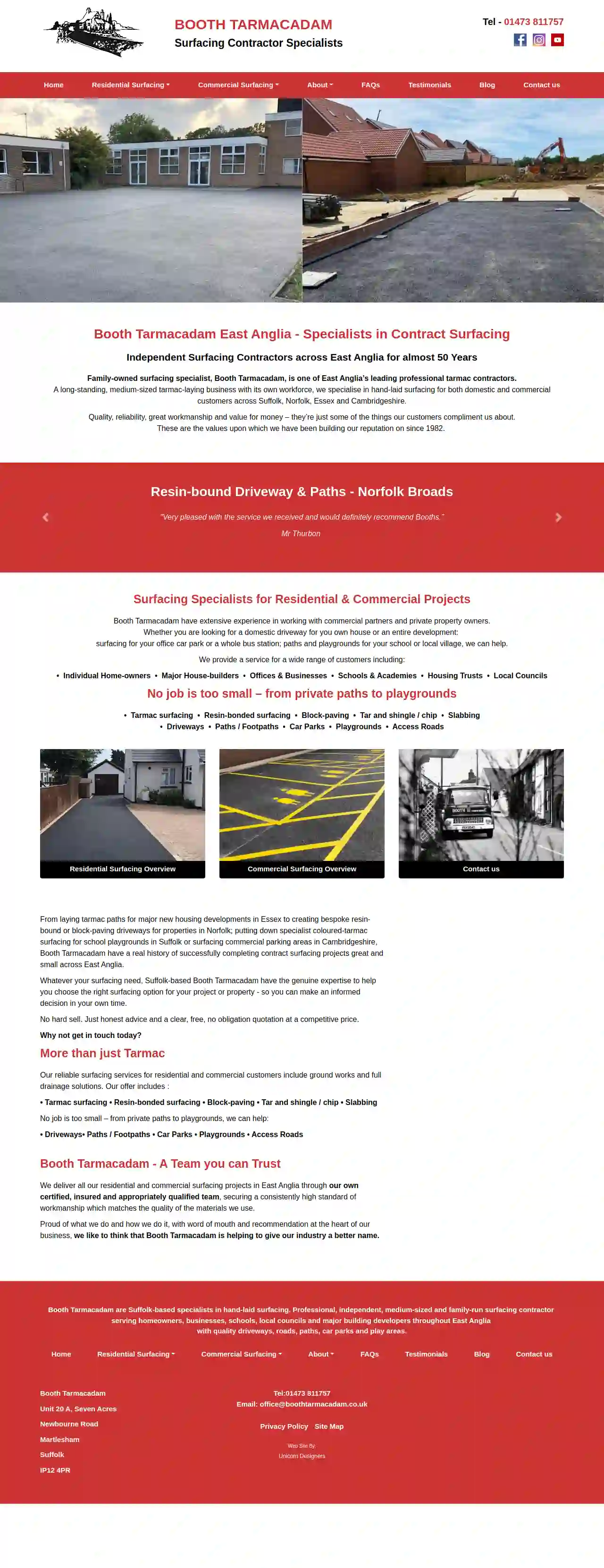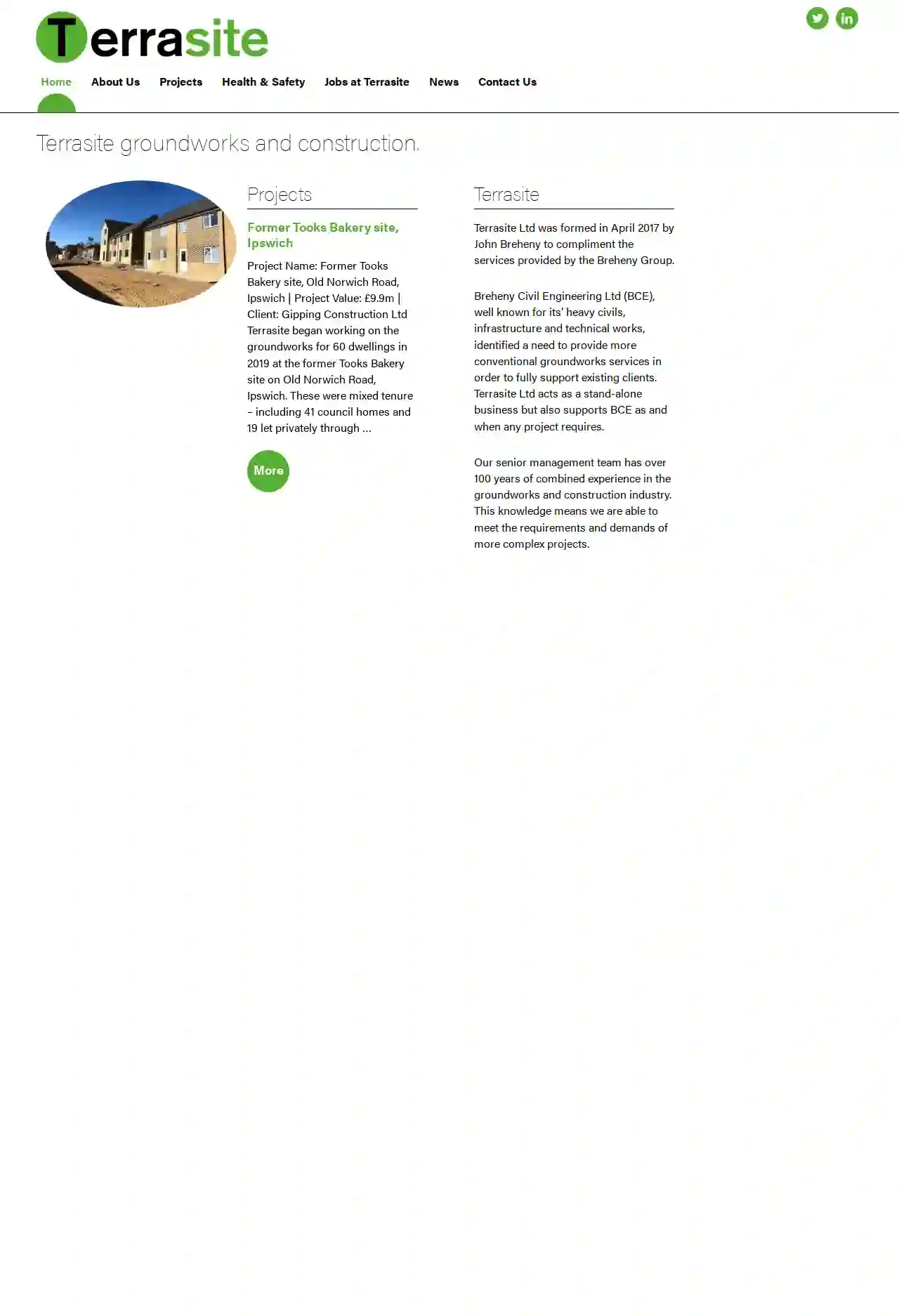Dirt Contractors Ipswich
Top 10 Dirt Hauling in Ipswich
Receive 3 FREE Dirt Contractors quotes for your project today! Compare profiles, reviews, accreditations, portfolio, etc... and choose the best deal.

New View Construction
55 reviewsMartlesham Heath, GBAbout New View Construction The directors of New View Construction have been in the building/construction industry for over 40 years. During that time we have been involved in contracts all over the country, working with various domestic and commercial contractors, gaining experience, trust and knowledge. We pride ourselves on high quality workmanship, together with a strong commitment to a professional tailored service. We are proud to have extensive experience and knowledge in the building/construction industry with reliable services and competitive pricing. We have a strong commitment to customer satisfaction and continuous site supervision that ensures high health and safety standards. We are based in Martlesham Heath, Ipswich and cover all of Suffolk & Essex and parts of Norfolk.
- Services
- Why Us?
- Gallery
Get Quote
WJS Contracting
4.574 reviewsIpswich, GBTake your yard to the next level Order a Firewood Delivery Today! QUALITY & PROFESSIONALISM WITH A SMILE More than just a contracting company Our goal at WJS Contracting is to handle all of your outdoor services with professionalism, quick communication, and a smile on our face. Headquartered just north of Boston MA, we bring the team and the lineup of heavy equipment to handle any size outdoor project. PROUD TO BE THE ONLY BOXWEDGE FIREWOOD PROVIDER IN MASSACHUSETTS Firewood delivered straight to your door As one of the largest firewood providers in New England, we offer a variety of firewood, including: green hardwood, semi seasoned hardwood, and seasoned hardwood. All delivered to you. WJS Contracting is the only company in Massachusetts with box wedge firewood!
- Services
- Why Us?
- Gallery
Get Quote
Booth Tarmacadam
4.73 reviewsCrane Court, 302 London Road, Ipswich, Suffolk, IP2 0AJ, GBBooth Tarmacadam East Anglia - Specialists in Contract Surfacing Independent Surfacing Contractors across East Anglia for almost 50 Years Family-owned surfacing specialist, Booth Tarmacadam, is one of East Anglia’s leading professional tarmac contractors. A long-standing, medium-sized tarmac-laying business with its own workforce, we specialise in hand-laid surfacing for both domestic and commercial customers across Suffolk, Norfolk, Essex and Cambridgeshire. Quality, reliability, great workmanship and value for money – they’re just some of the things our customers compliment us about. These are the values upon which we have been building our reputation on since 1982. Surfacing Specialists for Residential & Commercial Projects Booth Tarmacadam have extensive experience in working with commercial partners and private property owners. Whether you are looking for a domestic driveway for you own house or an entire development: surfacing for your office car park or a whole bus station; paths and playgrounds for your school or local village, we can help. We provide a service for a wide range of customers including: Individual Home-owners Major House-builders Offices & Businesses Schools & Academies Housing Trusts Local Councils No job is too small – from private paths to playgrounds Tarmac surfacing Resin-bonded surfacing Block-paving Tar and shingle / chip Slabbing Driveways Paths / Footpaths Car Parks Playgrounds Access Roads Booth Tarmacadam Ltd From laying tarmac paths for major new housing developments in Essex to creating bespoke resin-bound or block-paving driveways for properties in Norfolk; putting down specialist coloured-tarmac surfacing for school playgrounds in Suffolk or surfacing commercial parking areas in Cambridgeshire, Booth Tarmacadam have a real history of successfully completing contract surfacing projects great and small across East Anglia. Whatever your surfacing need, Suffolk-based Booth Tarmacadam have the genuine expertise to help you choose the right surfacing option for your project or property - so you can make an informed decision in your own time. No hard sell. Just honest advice and a clear, free, no obligation quotation at a competitive price. Why not get in touch today?
- Services
- Why Us?
- Testimonials
- Gallery
Get Quote
Geosphere Environmental Ltd
55 reviewsBrightwell Barns, Ipswich Road, Brightwell, Suffolk, IP10 0BJ, GBGeosphere Environmental: Your Partner in Environmental Solutions Geosphere Environmental Ltd is a client-focused, multi-disciplinary consultancy dedicated to providing comprehensive environmental solutions. Our simplified approach and commitment to quality have allowed us to assist clients with a wide range of projects, from small, single-plot developments to large-scale infrastructure projects. We offer a comprehensive suite of services, including contaminated land assessment, geotechnical investigations, ecology surveys, tree surveys, and visual inspections. Our team of experienced professionals is committed to delivering high-quality, cost-effective solutions that meet the specific needs of our clients. Since our establishment in 2009, Geosphere Environmental has grown to employ over thirty full-time staff, operating from our main office just outside of Ipswich. Our commitment to simplifying complex situations has earned us a loyal client base, including architects, local authorities, developers, utility suppliers, government bodies, and other consultants and designers. We pride ourselves on our client-centric approach, providing personalized solutions that are free from internal bureaucracy or competition. Our team is dedicated to building long-term relationships with our clients, ensuring their satisfaction and success.
- Services
- Why Us?
- Gallery
Get Quote
Landmark Construction Services Ltd
2.77 reviews11 Bullen Ln, Bramford, Ipswich, IP8 4JD, GBLandmark Construction We undertake contracts from both the private and commercial sectors, covering a wide range of different size projects, from small home and garden improvements, through to large housing and industrial estate developments. The Family owned and run business specialises in groundwork, civil engineering and new build projects for a variety of industrial and domestic clients. We pride ourselves on providing an efficient, flexible, reliable and competent service at all times. AN EXPERIENCED AND SKILLED TEAM The company is staffed by an experienced and skilled team, equipped to undertake a variety of projects irrespective of size and complexity. This also ensures that all work is tailored to meet the clients needs. A THOROUGH, HIGH STANDARD OF WORK The area of construction in which we operate is extremely competitive and it can be very difficult for anyone to consider using a new supplier. However, we can assure you that our staff consistently seek to provide a thorough, high standard of work and a level of service and reliability that ensures our customers are happy to return to us for their future requirements.
- Services
- Why Us?
- Our Team
- Gallery
Get Quote
Mark Barker Digger Services
548 reviewsIpswich, GBAbout Mark Barker Digger Services Mark Barker Digger Services is a trusted and experienced provider of mini digger hire with a driver for both commercial and residential customers in Ipswich and surrounding areas. With over 30 years of experience in civil engineering, Mark offers competitive rates and reliable service, ensuring your project is completed to the highest standards. Mark's expertise extends beyond mini digger hire. He also provides a 1-ton dumper for soil removal, making it a one-stop shop for your excavation needs. Mark's mini digger is a Kubota U17, boasting a dig depth of 2.3 meters, making it ideal for digging footings or trenches. Its compact size allows it to access tight spaces in residential properties, where larger diggers may struggle. The mini digger's precision leveling capabilities make it perfect for preparing the ground for patios or decking. Mark prides himself on transparency and reliability. Quotes are provided with no hidden extras, except for fuel charges, which are calculated based on usage. To ensure accurate costing, Mark encourages customers to provide as much information as possible about their project, including site access and photographs.
- Services
- Why Us?
- Our Team
- Gallery
Get Quote
Terrasite Ltd
51 reviewsFlordon Road, Creeting St Mary, Needham Market, Suffolk, IP6 8NH, GBTerrasite: Groundworks and Construction Terrasite Ltd was formed in April 2017 by John Breheny to compliment the services provided by the Breheny Group. Breheny Civil Engineering Ltd (BCE), well known for its’ heavy civils, infrastructure and technical works, identified a need to provide more conventional groundworks services in order to fully support existing clients. Terrasite Ltd acts as a stand-alone business but also supports BCE as and when any project requires. Our Experience Our senior management team has over 100 years of combined experience in the groundworks and construction industry. This knowledge means we are able to meet the requirements and demands of more complex projects. Our Values We believe in working ‘with’ our clients, ensuring any project is delivered to budget and to an agreed timescale. Using our knowledge and experience within our specific sector of groundworks we believe we can assist all our clients, should they so wish, to achieve the best overall result for any project regards buildability and value engineering. Our values remain that of the Breheny Group: We value our people, customers and suppliers. We treat our people fairly and equitably. We want our people to enjoy their work and progress their careers in a stable, safe environment. We seek repeat business from customers. We develop good relationships with suppliers. We have respect for the community and environment. We minimise our impact on the environment and the communities in which we work. We support community projects that involve our employees. We believe in openness and honesty. We comply with all applicable law. We work as a team with our customers. We keep our people informed of developments within the Company We take pride in what we do. We do everything to the highest possible standard. We reinvest profits to maintain an extensive and modern plant fleet. We continuously improve our performance. “Breheny is a family business that builds long term relationships with its customers through the quality of its workmanship and the excellent service it provides.” – John Breheny, Chairman.
- Services
- Why Us?
- Gallery
Get Quote
Over 3,630+ Excavation Businesses onboarded
Our excavation pros operate in Ipswich and surrounding areas!
ExcavationHQ has curated and vetted the Best Excavation Contractors arround Ipswich. Find a reliable pro today.
Frequently Asked Questions About Dirt Contractors
- Designated Disposal Facilities: Contact your local waste management authority or search online for designated dirt and debris disposal facilities in your area. They accept various types of soil and construction materials.
- Recycling Centers: Some recycling centers accept clean fill dirt, concrete, or brick for reuse in other construction projects.
- Donation: If the dirt is clean and suitable for gardening or landscaping, consider donating it to community gardens, schools, or neighbors with landscaping projects.
- For Structural Fill: Use compacted granular fill, such as gravel or crushed stone, for stability and drainage. Avoid using organic materials like topsoil or wood chips, as they decompose and can create voids over time.
- For Landscaping: If you plan to plant in the filled area, use a blend of topsoil and fill dirt. This provides a balance of fertility and structure. Amend the soil with compost or other organic matter to enhance its drainage and nutrient content.
- For Drainage: If the hole is intended for drainage, use a layer of gravel or crushed stone at the bottom to improve water flow. Then, backfill with a porous soil mix that allows water to percolate through.
- Clean Fill: Consists of uncontaminated soil, rock, or gravel, free from organic matter, debris, or hazardous substances. Suitable for most construction and landscaping projects.
- Structural Fill: A compacted granular fill, typically gravel, crushed stone, or a mixture of both, used for structural support and drainage. Ideal for foundations, roadways, and retaining walls.
- Engineered Fill: A specifically designed and blended soil mix with controlled properties, such as compaction, drainage, or bearing capacity, tailored for particular applications.
- Unsuitable Fill: Materials like topsoil, organic matter, or contaminated soil that are not suitable for structural fill due to their potential for decomposition, settlement, or environmental concerns.
What is the best way to dispose of excess dirt?
What type of dirt is best for filling a hole?
What is the difference between screened topsoil and unscreened topsoil?
Screened Topsoil: Processed through a screening machine to remove large debris, rocks, and clumps, resulting in a finer and more uniform texture. It's generally considered higher quality and is preferred for landscaping, gardening, and lawn establishment.
Unscreened Topsoil: Not processed through a screening machine and may contain various sizes of debris, rocks, and clumps. It's typically less expensive than screened topsoil but may require additional work to remove debris before use.
Choosing between screened and unscreened topsoil depends on your project's specific needs and budget.
What are the different types of fill dirt?
What is the best way to dispose of excess dirt?
- Designated Disposal Facilities: Contact your local waste management authority or search online for designated dirt and debris disposal facilities in your area. They accept various types of soil and construction materials.
- Recycling Centers: Some recycling centers accept clean fill dirt, concrete, or brick for reuse in other construction projects.
- Donation: If the dirt is clean and suitable for gardening or landscaping, consider donating it to community gardens, schools, or neighbors with landscaping projects.
What type of dirt is best for filling a hole?
- For Structural Fill: Use compacted granular fill, such as gravel or crushed stone, for stability and drainage. Avoid using organic materials like topsoil or wood chips, as they decompose and can create voids over time.
- For Landscaping: If you plan to plant in the filled area, use a blend of topsoil and fill dirt. This provides a balance of fertility and structure. Amend the soil with compost or other organic matter to enhance its drainage and nutrient content.
- For Drainage: If the hole is intended for drainage, use a layer of gravel or crushed stone at the bottom to improve water flow. Then, backfill with a porous soil mix that allows water to percolate through.
What is the difference between screened topsoil and unscreened topsoil?
Screened Topsoil: Processed through a screening machine to remove large debris, rocks, and clumps, resulting in a finer and more uniform texture. It's generally considered higher quality and is preferred for landscaping, gardening, and lawn establishment.
Unscreened Topsoil: Not processed through a screening machine and may contain various sizes of debris, rocks, and clumps. It's typically less expensive than screened topsoil but may require additional work to remove debris before use.
Choosing between screened and unscreened topsoil depends on your project's specific needs and budget.
What are the different types of fill dirt?
- Clean Fill: Consists of uncontaminated soil, rock, or gravel, free from organic matter, debris, or hazardous substances. Suitable for most construction and landscaping projects.
- Structural Fill: A compacted granular fill, typically gravel, crushed stone, or a mixture of both, used for structural support and drainage. Ideal for foundations, roadways, and retaining walls.
- Engineered Fill: A specifically designed and blended soil mix with controlled properties, such as compaction, drainage, or bearing capacity, tailored for particular applications.
- Unsuitable Fill: Materials like topsoil, organic matter, or contaminated soil that are not suitable for structural fill due to their potential for decomposition, settlement, or environmental concerns.